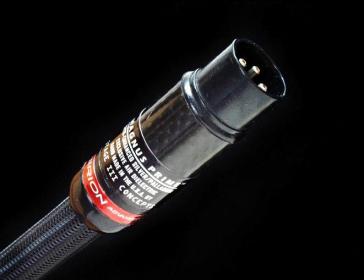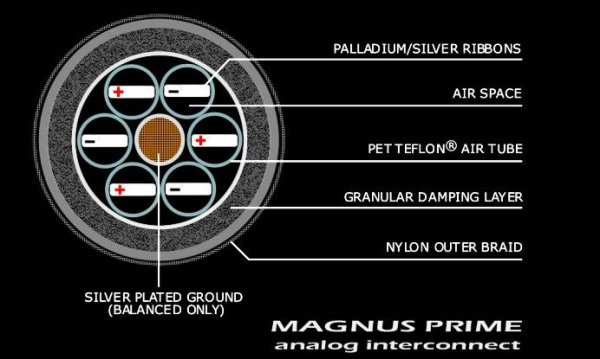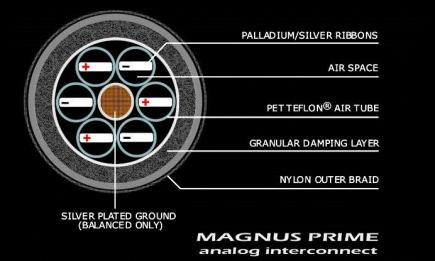Stage III Concepts
Magnus Prime Analog Interconnects
Nicholas Bedworth
Introduction
The voicing of a reference-grade sound system derives from the personality of keycomponents. While it’s certainly natural to think of “big ticket” items, such as amps, DACs, and speakers, dominating the equation, these days even moderately-priced electronics and transducers can be extraordinarily neutral and balanced. My personal preference and strategy has been to pay special attention to the cabling connecting the source to the amps, and then to the speakers.
Why? Well, it’s pretty easy to find electronics that will greatly outperform the cabling found connecting them. Conversely, it’s hard to find cabling that lets all the inherent goodness in quality components reach your ears. It takes an exceptional cable to extract the performance that’s latent in so many DACs and amps—even relatively modestly-priced ones.
Stage III, based in Pasadena, CA, takes a rather unusual approach in the design of most of their cables, compared to the conventional wisdom. In the case of the Stage III’s Magnus Prime analog interconnect—one step below their Gryphon reference level—lead designer Luis de la Fuente employs a novel palladium-silver alloy to great advantage.
To my ear, the overall sound has many of silver’s detail and delicacy, without the “optimism” or gentle elevation of timbre. While many factors are involved, of course, using palladium-silver conductors seems like a fundamentally-important distinction, compared to copper or all-silver.
Exotic materials
Each Magnus Prime comprises three pairs of custom-extruded, hand-polished and cryo-bath-soaked AeroStrand Ultra palladium-silver, uninsulated, twisted-ribbon flat conductors. These in turn spiral around a silver-plated ground, in the case of XLR configurations. Each conductor has its own hermetically-sealed Teflon air tube, resulting in a 6-tube core, which is then encapsulated in microphonic-reducing granular ceramic damping material.
Just give a gentle tap to air-tube cables that don’t use enough damping, and you’ll quickly appreciate why controlling microphonics (the conversion of mechanical energy into sonic artifacts) is essential.

One quality that quickly becomes apparent upon visual inspection is the high level of build quality. The Magnus Prime sports finely-woven external sheathing that, at each end, disappears inside custom-made carbon-fiber Hyperion shells with ceramic-infused polymer central inserts. The fit-and-finish is superb, especially when compared to that of other brands where heat-shrink is often employed.
The XLR shells don’t use press-to-release locking pins, but instead rely upon an alignment ridge and small bump that seats itself inside the matching receptacle. Inserting and removing the cables doesn’t require the audiophile-equivalent of a tug-of-war, but on the other hand, the mating of the connectors is secure enough that they won’t disconnect accidentally. And unlike many high-end cables, the Magnus Prime are exceptionally easy to install anda rrange. They’re quite flexible compared to unnamed-cable-as-Burmese-python competitors that require a large bending radius, or can easily lift lightweight components off the rack.
Despite being in the business of selling cabling by the meter, Luis recommends using the shortest practical length of Magnus Primes to get best results. Fortunately, the pliable mechanical qualities of his design make it easy to connect close-together components; our python friends along with their rigid-air-tube relatives can easily require several feet to make a round-trip. Less-is-more, at least for this particular type of cable technology.
Sonic Impressions
One of my high-priority criteria for cables or components is evaluating to what degree they constrict the soundstage, dynamics or timbre. With the Magnus Primes, it’s clear from even the first few seconds of listening that they are extraordinarily open, unrestricted and neutral. There’s a spaciousness to the bottom end and lower mid-range that helps bring the performance hall into the listening room; they project a wide, deep and high soundstage that’s anchored by all the low-frequency sonic cues.
Arranged within this acoustical foundation, instruments, voices, reverberation appear against a background of utter silence and neutrality. One of the most striking results of ultra-refined resolution, focus and clarity is a central image that’s rock-solid, pronounced and three-dimensional. Detail and accuracy are at the highest level: Every nuance of the performance and recording technique—for better or worse—is going to be readily apparent.
Starting with the “or worse” category, the HD Tracks 176 kHz, 24 bit remastering of theRolling Stones’ Let it Bleed is averitable education in substandard recordings, unearthed and resuscitated as much as possible by the heroic efforts of veteran recording engineer Bob Ludwig.
The opening cut, Gimme Shelter, has all the dynamics and frequency response of, say, a garage band playing somewhere down the street, or, possibly, underwater. There’s very little difference between monophonic and stereo settings on my DAC. It’s really awful, but the given the condition of the tapes and the limitations of the original recording, it’s probably as good as can be expected.

In the title song, Let it Bleed, the frequency extension is enormously improved, the instruments are clear with plenty of punch, although the sense of any real soundstaging is modest. In this case, the minor limitations of the sound don’t detract from the entertainment value of the track’s raunchy lyrics and gross-out humor. What more could a teenager want? Even a relatively recent (2011) National Public Radio music blog on Let it Bleed couldn’t quite bring itself to actually quote the words. You probably don't want to know what they are.
Yes, you too can experience a $200K reference system reduced to the level of a 1985 car radio, but the point here is that the Magnus Primes are totally revealing, and completely unforgiving. Nothing is obscured, which on good recordings, is of course just what’s desired.
In the “better” category, Diana Krall’s slightly-dry, raspy and closely-mike drendition of Temptation gets even the most reserved guest to my listening room moving around in the chair, tapping his feet and looking straight at an ephemeral performer fixed squarely between the speakers. While Diana’s track might be monophonic, and the rest of the artists are captured with somewhat more air and dimensionality, the central fill is stunning, to put it mildly. You’ll understand the personality of her voice like never before.
And moving on to “best”, Brian Bloomberg’s 2008 rendition of The Chicken with its spectacular yet completely accurate bass guitar snap, detail and dynamics will shiver your timbers. The background is quiet, silent, free from grain, and the notes jump out in an almost startling fashion. The playing is visceral, lively, funny, and is an excellent demonstration of top-to-bottom sonic coherence: The timbre is realistic, convincing and engaging at every pitch along the way.
At the other end of the artistic spectrum, Herbert Tachezi’s interpretation of the Bach Toccata and Fugue in D minor on the 1755 Silbermann Organ pierces, rumbles and delights the air of the Dresden Cathedral, with complex and rich reverberations returning from every corner of the vast interior space.
Conclusion
It’s hard to describe interconnect that doesn’t have much sonic character. It’s not warm, not cold, not dark or bright... basically, it’s just right, meaning it really isn’t there at all. And the benefit of this lack of character is that whatever is on the tape, that’s what you’re going to hear. The Magnus Primelets you spend much more time listening to the music, rather than to the system. You’ll hear all that there is to hear, to a farethewell.
Manufacturer’sWeb site
www.stage3concepts.com
Pricing and general specifications
StageIII Concepts Magnus Prime analog interconnect cables; XLR version: $2,900 1 meter pair; $1,000 each additional 0.5 meter.
Review system details
Sources: Antelope Gold DAC with Voltikus power supply; Audiophilleo1 USB-S/PDIFtransport-processor; Toshiba Qosmio laptop; HP HDX 18 laptop; Seagate 1.5 TB external digital media storage.
House clock: Grimm Audio CC-1 word clock.
Power management: Synergistic Research Tesla PowerCell 10 SE Mk II, Quantum Line Strip QLS 9, Galileo MiniPower
Coupler, Tesla SE Hologram A power cable, Tesla SE Hologram D powercable, Tesla SE Precision AC power cable, Enigma Active Shielding TuningCircuits, MiG Mechanical Interface Grounding, BiG MiG.
Amplifiers: Pass XA 200.5 monoblocks.
Speakers: P erfect8 The Point Mk II dipoles with powered subwoofers.
Software: J. River Media Player 17.
Audiocabling: Stage III Magnus Prime full-range speaker cables; Stage III MagnusPrime analogue interconnects; AudioQuest Carbon USB cables.
Room1: 18’ deep, 12’ wide, 8’ to 11’ ceiling
Magnus Prime Analog Interconnects
Nicholas Bedworth
Introduction
The voicing of a reference-grade sound system derives from the personality of keycomponents. While it’s certainly natural to think of “big ticket” items, such as amps, DACs, and speakers, dominating the equation, these days even moderately-priced electronics and transducers can be extraordinarily neutral and balanced. My personal preference and strategy has been to pay special attention to the cabling connecting the source to the amps, and then to the speakers.
Why? Well, it’s pretty easy to find electronics that will greatly outperform the cabling found connecting them. Conversely, it’s hard to find cabling that lets all the inherent goodness in quality components reach your ears. It takes an exceptional cable to extract the performance that’s latent in so many DACs and amps—even relatively modestly-priced ones.
Stage III, based in Pasadena, CA, takes a rather unusual approach in the design of most of their cables, compared to the conventional wisdom. In the case of the Stage III’s Magnus Prime analog interconnect—one step below their Gryphon reference level—lead designer Luis de la Fuente employs a novel palladium-silver alloy to great advantage.
To my ear, the overall sound has many of silver’s detail and delicacy, without the “optimism” or gentle elevation of timbre. While many factors are involved, of course, using palladium-silver conductors seems like a fundamentally-important distinction, compared to copper or all-silver.
Exotic materials
Each Magnus Prime comprises three pairs of custom-extruded, hand-polished and cryo-bath-soaked AeroStrand Ultra palladium-silver, uninsulated, twisted-ribbon flat conductors. These in turn spiral around a silver-plated ground, in the case of XLR configurations. Each conductor has its own hermetically-sealed Teflon air tube, resulting in a 6-tube core, which is then encapsulated in microphonic-reducing granular ceramic damping material.
Just give a gentle tap to air-tube cables that don’t use enough damping, and you’ll quickly appreciate why controlling microphonics (the conversion of mechanical energy into sonic artifacts) is essential.

One quality that quickly becomes apparent upon visual inspection is the high level of build quality. The Magnus Prime sports finely-woven external sheathing that, at each end, disappears inside custom-made carbon-fiber Hyperion shells with ceramic-infused polymer central inserts. The fit-and-finish is superb, especially when compared to that of other brands where heat-shrink is often employed.
The XLR shells don’t use press-to-release locking pins, but instead rely upon an alignment ridge and small bump that seats itself inside the matching receptacle. Inserting and removing the cables doesn’t require the audiophile-equivalent of a tug-of-war, but on the other hand, the mating of the connectors is secure enough that they won’t disconnect accidentally. And unlike many high-end cables, the Magnus Prime are exceptionally easy to install anda rrange. They’re quite flexible compared to unnamed-cable-as-Burmese-python competitors that require a large bending radius, or can easily lift lightweight components off the rack.
Despite being in the business of selling cabling by the meter, Luis recommends using the shortest practical length of Magnus Primes to get best results. Fortunately, the pliable mechanical qualities of his design make it easy to connect close-together components; our python friends along with their rigid-air-tube relatives can easily require several feet to make a round-trip. Less-is-more, at least for this particular type of cable technology.
Sonic Impressions
One of my high-priority criteria for cables or components is evaluating to what degree they constrict the soundstage, dynamics or timbre. With the Magnus Primes, it’s clear from even the first few seconds of listening that they are extraordinarily open, unrestricted and neutral. There’s a spaciousness to the bottom end and lower mid-range that helps bring the performance hall into the listening room; they project a wide, deep and high soundstage that’s anchored by all the low-frequency sonic cues.
Arranged within this acoustical foundation, instruments, voices, reverberation appear against a background of utter silence and neutrality. One of the most striking results of ultra-refined resolution, focus and clarity is a central image that’s rock-solid, pronounced and three-dimensional. Detail and accuracy are at the highest level: Every nuance of the performance and recording technique—for better or worse—is going to be readily apparent.
Starting with the “or worse” category, the HD Tracks 176 kHz, 24 bit remastering of theRolling Stones’ Let it Bleed is averitable education in substandard recordings, unearthed and resuscitated as much as possible by the heroic efforts of veteran recording engineer Bob Ludwig.
The opening cut, Gimme Shelter, has all the dynamics and frequency response of, say, a garage band playing somewhere down the street, or, possibly, underwater. There’s very little difference between monophonic and stereo settings on my DAC. It’s really awful, but the given the condition of the tapes and the limitations of the original recording, it’s probably as good as can be expected.

In the title song, Let it Bleed, the frequency extension is enormously improved, the instruments are clear with plenty of punch, although the sense of any real soundstaging is modest. In this case, the minor limitations of the sound don’t detract from the entertainment value of the track’s raunchy lyrics and gross-out humor. What more could a teenager want? Even a relatively recent (2011) National Public Radio music blog on Let it Bleed couldn’t quite bring itself to actually quote the words. You probably don't want to know what they are.
Yes, you too can experience a $200K reference system reduced to the level of a 1985 car radio, but the point here is that the Magnus Primes are totally revealing, and completely unforgiving. Nothing is obscured, which on good recordings, is of course just what’s desired.
In the “better” category, Diana Krall’s slightly-dry, raspy and closely-mike drendition of Temptation gets even the most reserved guest to my listening room moving around in the chair, tapping his feet and looking straight at an ephemeral performer fixed squarely between the speakers. While Diana’s track might be monophonic, and the rest of the artists are captured with somewhat more air and dimensionality, the central fill is stunning, to put it mildly. You’ll understand the personality of her voice like never before.
And moving on to “best”, Brian Bloomberg’s 2008 rendition of The Chicken with its spectacular yet completely accurate bass guitar snap, detail and dynamics will shiver your timbers. The background is quiet, silent, free from grain, and the notes jump out in an almost startling fashion. The playing is visceral, lively, funny, and is an excellent demonstration of top-to-bottom sonic coherence: The timbre is realistic, convincing and engaging at every pitch along the way.
At the other end of the artistic spectrum, Herbert Tachezi’s interpretation of the Bach Toccata and Fugue in D minor on the 1755 Silbermann Organ pierces, rumbles and delights the air of the Dresden Cathedral, with complex and rich reverberations returning from every corner of the vast interior space.
Conclusion
It’s hard to describe interconnect that doesn’t have much sonic character. It’s not warm, not cold, not dark or bright... basically, it’s just right, meaning it really isn’t there at all. And the benefit of this lack of character is that whatever is on the tape, that’s what you’re going to hear. The Magnus Primelets you spend much more time listening to the music, rather than to the system. You’ll hear all that there is to hear, to a farethewell.
Manufacturer’sWeb site
www.stage3concepts.com
Pricing and general specifications
StageIII Concepts Magnus Prime analog interconnect cables; XLR version: $2,900 1 meter pair; $1,000 each additional 0.5 meter.
Review system details
Sources: Antelope Gold DAC with Voltikus power supply; Audiophilleo1 USB-S/PDIFtransport-processor; Toshiba Qosmio laptop; HP HDX 18 laptop; Seagate 1.5 TB external digital media storage.
House clock: Grimm Audio CC-1 word clock.
Power management: Synergistic Research Tesla PowerCell 10 SE Mk II, Quantum Line Strip QLS 9, Galileo MiniPower
Coupler, Tesla SE Hologram A power cable, Tesla SE Hologram D powercable, Tesla SE Precision AC power cable, Enigma Active Shielding TuningCircuits, MiG Mechanical Interface Grounding, BiG MiG.
Amplifiers: Pass XA 200.5 monoblocks.
Speakers: P erfect8 The Point Mk II dipoles with powered subwoofers.
Software: J. River Media Player 17.
Audiocabling: Stage III Magnus Prime full-range speaker cables; Stage III MagnusPrime analogue interconnects; AudioQuest Carbon USB cables.
Room1: 18’ deep, 12’ wide, 8’ to 11’ ceiling
Attachments
Last edited:















